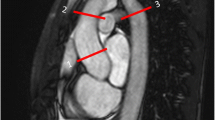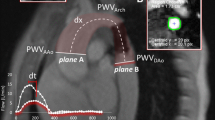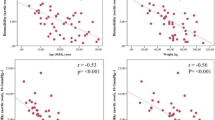Abstract
Abnormal elastic properties of the ascending aorta in patients with coarctation of the aorta (CoA) are already present in neonates before and after successful repair. To prove the midterm outcome for vascular pathology, a cohort of 15 patients was prospectively reevaluated. In this study, 15 patients after neonatal CoA repair (study group) and 15 healthy normal children (control group) were examined (mean age, 3.0 ± 1.0 years). The aortic wall stiffness index and distensibility were calculated using ascending and abdominal aortic M-mode diameters and noninvasive estimation of pulse pressure. The study group was compared with the control group and with its own previously obtained pre- and postoperative measurements. After a mean follow-up period of 2.9 ± 0.9 years, the elastic properties of the ascending aorta remained impaired in the study group compared with the control group (distensibility: 62 ± 28 vs 94 ± 34; p = 0.01; stiffness index: 4.4 ± 1.9 vs 2.7 ± 1.0; p = 0.008). At follow-up evaluation, the elasticity of the ascending aorta in the study group showed no change from the initial neonatal findings (distensibility: 63 ± 24 vs 62 ± 28; p = 0.82; stiffness index: 4.0 ± 1.6 vs 4.4 ± 1.9; p = 0.65). In both groups, descending aortic elasticity increased during the follow-up period. Our data suggest that the diminished elastic properties of the prestenotic arteries remain unchanged years after successful CoA repair. Comparisons with the neonatal data showed no evidence for remodeling of the ascending aorta in this group.

Similar content being viewed by others
References
Baumgartner D, Baumgartner C, Matyas G et al (2005) Diagnostic power of aortic elastic properties in young patients with Marfan syndrome. J Thorac Cardiovasc Surg 129:730–739
Borow KM, Newburger JW (1982) Noninvasive estimation of central aortic pressure using the oscillometric method for analyzing systemic artery pulsatile blood flow: comparative study of indirect systolic, diastolic, and mean brachial artery pressure with simultaneous direct ascending aortic pressure measurements. Am Heart J 103:879–886
Boutouyrie P, Tropeano AI, Asmar R et al (2002) Aortic stiffness is an independent predictor of primary coronary events in hypertensive patients. Hypertension 39:10–15
Brili S, Tousoulis D, Antoniades C et al (2005) Evidence of vascular dysfunction in young patients with successfully repaired coarctation of aorta. Atherosclerosis 182:97–103
Cohen M, Fuster V, Steele PM et al (1989) Coarctation of the aorta: long-term follow-up and prediction of outcome after surgical correction. Circulation 80:840–845
Daniels SR (2001) Repair of coarctation of the aorta and hypertension: does age matter? Lancet 358:89
de Divitiis M, Pilla C, Kattenhorn M et al (2001) Vascular dysfunction after repair of coarctation of the aorta: impact of early surgery. Circulation 104:165–170
Dernellis J, Panaretou M (2005) Aortic stiffness is an independent predictor of progression to hypertension in nonhypertensive subjects. Hypertension 45:426–431
Eicken A, Pensl U, Sebening W et al (2006) The fate of systemic blood pressure in patients after effectively stented coarctation. Eur Heart J 27:1100–1105
Gardiner HM, Celermajer DS, Sorensen KE et al (1994) Arterial reactivity is significantly impaired in normotensive young adults after successful repair of aortic coarctation in childhood. Circulation 89:1745–1750
Heger M, Willfort A, Neunteufl T et al (2005) Vascular dysfunction after coarctation repair is related to the age at surgery. Int J Cardiol 99:295–299
Kim GB, Kang SJ, Bae EJ et al (2004) Elastic properties of the ascending aorta in young children after successful coarctoplasty in infancy. Int J Cardiol 97:471–477
Laurent S, Boutouyrie P, Asmar R et al (2001) Aortic stiffness is an independent predictor of all-cause and cardiovascular mortality in hypertensive patients. Hypertension 37:1236–1241
National High Blood Pressure Education Program Working Group on High Blood Pressure in Children, Adolescents (2004) The fourth report on the diagnosis, evaluation, and treatment of high blood pressure in children and adolescents. Pediatrics 114:555–576
O’Sullivan JJ, Derrick G, Darnell R (2002) Prevalence of hypertension in children after early repair of coarctation of the aorta: a cohort study using casual and 24-hour blood pressure measurement. Heart 88:163–166
Ong CM, Canter CE, Gutierrez FR et al (1992) Increased stiffness and persistent narrowing of the aorta after successful repair of coarctation of the aorta: relationship to left ventricular mass and blood pressure at rest and with exercise. Am Heart J 123:1594–1600
Ou P, Celermajer DS, Mousseaux E et al (2007) Vascular remodeling after “successful” repair of coarctation: impact of aortic arch geometry. J Am Coll Cardiol 49:883–890
Polson J, McCallion N, Waki H et al (2006) Evidence for cardiovascular autonomic dysfunction in neonates with coarctation of the aorta. Circulation 113:2844–2850
Sahn A, DeMaria DJ, Kisslo J, Weyman A (1978) Recommendations regarding quantitation in M-mode echocardiography: results of a survey of echocardiographic measurements. Circulation 58:1072–1083
Vogt M, Kühn A, Baumgartner D et al (2005) Impaired elastic properties of the ascending aorta in newborns before and early after successful coarctation repair: proof of a systemic vascular disease of the prestenotic arteries? Circulation 111:3269–3273
Wessel A, von Samson-Himmelstjerna MC, Ruschewski W, Bursch JH (1995) Effects of age in the correction of isthmus stenosis on postoperative stiffness of the aorta. Z Kardiol 84:237–242
Author information
Authors and Affiliations
Corresponding author
Rights and permissions
About this article
Cite this article
Kühn, A., Baumgartner, D., Baumgartner, C. et al. Impaired Elastic Properties of the Ascending Aorta Persist Within the First 3 Years After Neonatal Coarctation Repair. Pediatr Cardiol 30, 46–51 (2009). https://doi.org/10.1007/s00246-008-9280-6
Received:
Revised:
Accepted:
Published:
Issue Date:
DOI: https://doi.org/10.1007/s00246-008-9280-6




